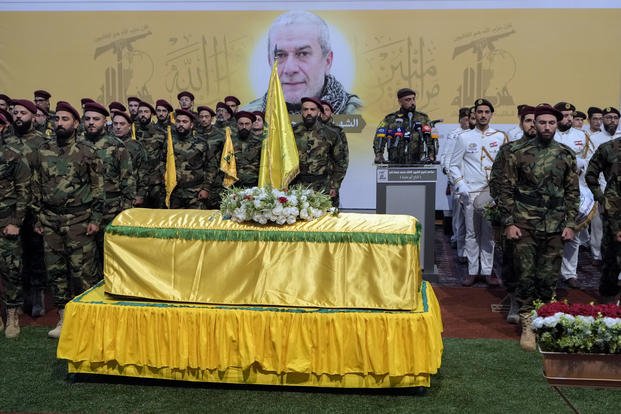

BEIRUT (AP) — The Lebanese Hezbollah group said it launched over 200 rockets on Thursday at several military bases in Israel in retaliation for a strike that killed one of its senior commanders.
The attack by the Iran-backed militant group was one of the largest in the monthslong conflict along the Lebanon-Israel border, with tensions escalating in recent weeks.
The Israeli military said “numerous projectiles and suspicious aerial targets” had entered its territory from Lebanon, many of which it said were intercepted. It confirmed the death of one soldier in the barrage.
It said about 200 “projectiles” were launched toward the Israeli-annexed Golan Heights and over 20 drones into Israeli territory, but that it had intercepted some of them.
After Hezbollah’s attack, Israel struck various towns in southern Lebanon. The Israeli military said it hit Hezbollah’s “military structures” in the southern border towns of Ramyeh and Houla. Lebanon’s state-run National News Agency reported that an Israeli drone strike of Houla killed at least one person. Israeli jets also broke the sound barrier over the Lebanese capital, Beirut, and other areas in the country.
Israel on Wednesday acknowledged that it had killed Mohammad Naameh Nasser, who headed one of Hezbollah’s three regional divisions in southern Lebanon, a day earlier.
Hours after the killing, Hezbollah launched scores of Katyusha rockets and Falaq rockets with heavy warheads into northern Israel and the Golan. It launched more rockets on Thursday and said it had also sent exploding drones into several bases. Israel captured the Golan, a strategic plateau, from Syria in the 1967 Mideast war in a move that is recognized by the United States but otherwise rejected by the international community.
Hashem Safieddine, head of Hezbollah’s Executive Council, vowed that the group will continue its retaliatory attacks, “targeting new sites they never imagined would be hit.”
“The enemy sometimes acknowledges these hits and sometimes does not, but it is certain that there have been many casualties,” he said at Nasser’s funeral.
Nasser was of great importance to Hezbollah, which said he took part in battles in conflicts in Syria and Iraq from 2011 until 2016 and fought in the group’s last war with Israel in 2006. Two other senior Hezbollah commanders have also been killed.
The U.S. and France are continuing to scramble to prevent the skirmishes from spiraling into an all-out war, which they fear could spillover across the region. Washington in its shuttle diplomatic efforts initially hoped for calm along the Lebanon-Israel border in a deal that is not linked to the war in Gaza. However, since the U.S. has called for Hamas to agree to a cease-fire proposal presented by President Joe Biden, it has said that an end to the war in Gaza would lead to calm in Lebanon and northern Israel as well.
The relatively low-level conflict erupted shortly after the outbreak of the war in Gaza. Hezbollah says it is striking Israel in solidarity with Hamas, another Iran-allied group that ignited the war in Gaza with its Oct. 7 attack into southern Israel. The group’s leadership says it will stop its attacks once there is a cease-fire in Gaza, and that while it does not want war, it is ready for one.
Israeli officials, meanwhile, say they could decide to go to war in Lebanon if efforts for a diplomatic solution fail.
Hezbollah’s retaliation comes a day after a senior adviser to U.S. President Joe Biden, Amos Hochstein, met with French President Emmanuel Macron’s Lebanon envoy, Jean-Yves Le Drian, in Paris.
The fighting has displaced tens of thousands of people on both sides of the border. In northern Israel, 16 soldiers and 11 civilians have been killed. In Lebanon, more than 450 people — mostly fighters but also dozens of civilians — have been killed.
Israel sees Hezbollah as its most direct threat and estimates that it has an arsenal of 150,000 rockets and missiles, including precision-guided missiles.
In 2006, Israel and Hezbollah fought a monthlong war that ended in a draw.
© Copyright 2024 Associated Press. All rights reserved. This material may not be published, broadcast, rewritten or redistributed.
